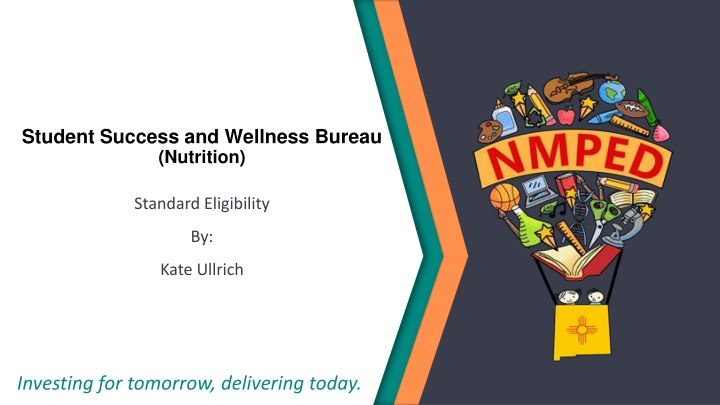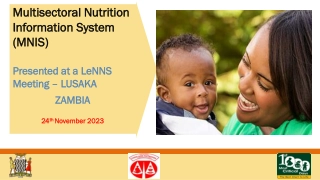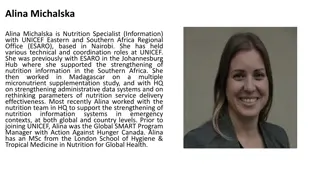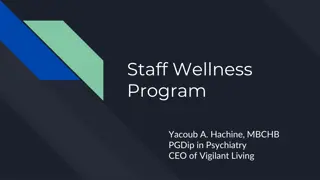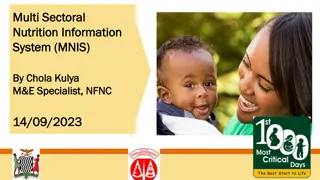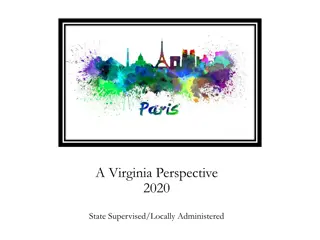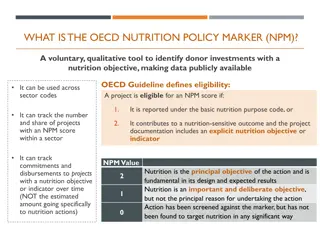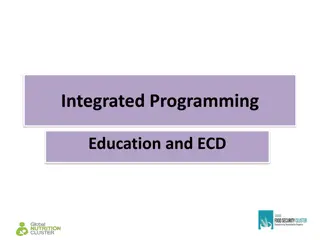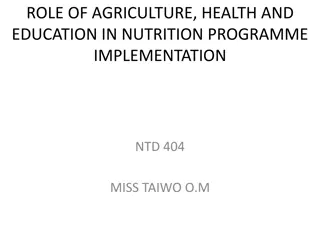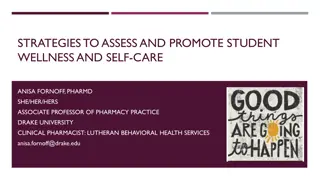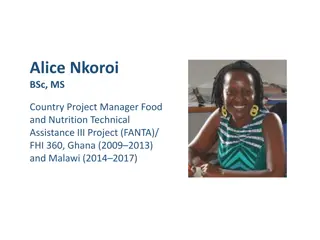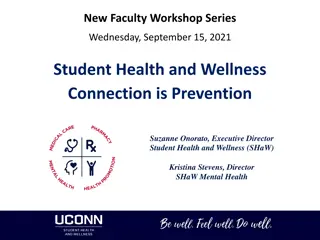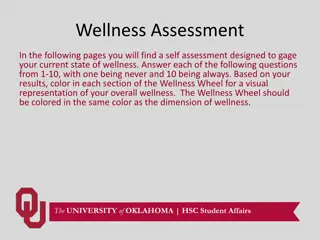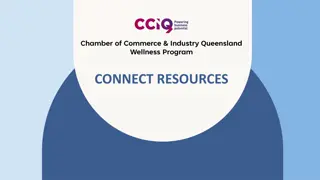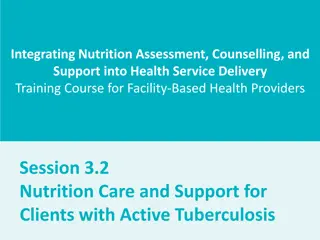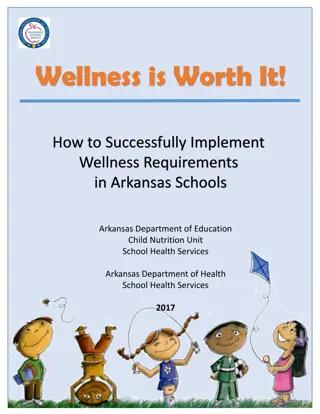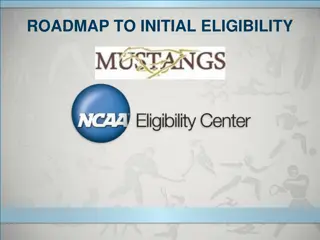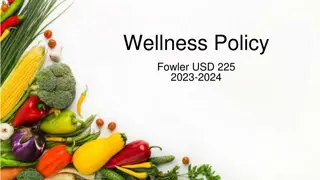Student Success & Wellness Bureau (Nutrition) Standard Eligibility
The Student Success & Wellness Bureau's Nutrition department outlines the process for determining eligibility for free and reduced-price meal benefits, including distributing applications, processing them in a timely manner, and conducting verifications to ensure eligible families are notified promptly. The bureau supports household outreach and provides resources such as prototypes and guidelines to streamline the application process.
Download Presentation

Please find below an Image/Link to download the presentation.
The content on the website is provided AS IS for your information and personal use only. It may not be sold, licensed, or shared on other websites without obtaining consent from the author.If you encounter any issues during the download, it is possible that the publisher has removed the file from their server.
You are allowed to download the files provided on this website for personal or commercial use, subject to the condition that they are used lawfully. All files are the property of their respective owners.
The content on the website is provided AS IS for your information and personal use only. It may not be sold, licensed, or shared on other websites without obtaining consent from the author.
E N D
Presentation Transcript
Student Success and Wellness Bureau (Nutrition) Standard Eligibility By: Kate Ullrich Investing for tomorrow, delivering today.
Overview Distributing Applications & Household Outreach Processing Applications Determining Eligibility Notifications to Families of the Eligibility Determinations Outcomes Conducting Verifications 2 Investing for tomorrow, delivering today.
Distributing Applications & Household Outreach Prototypes Google Drive: https://drive.google.com/drive/folders/1wt0lypJTh2Uo5F36azdUoMyBw6n2SEoM?usp= sharing Prototype: USDA Application for Free and Reduced Meals updated with USDA Income Guidelines Prototype: Instructions for Households Free & Reduced Meals Prototype: Household Notice for Free and Reduced Meals Prototype: FAQ s for Households Free and Reduced Meals USDA Income Guidelines SFA s can pre-populate data (other than income data) from the prior school year or from STARS. 3 Investing for tomorrow, delivering today.
Distributing Applications & Household Outreach SFAs must ensure all households receive an application for free and reduced price meal benefits. Applications may be distributed by the postal service, e-mailed to the parent or guardian, or included in information packets provided to students. Due Date: Beginning of School Year 4 Investing for tomorrow, delivering today.
Processing Applications
Processing Applications Applications must be reviewed in a timely manner. Whenever possible, applications should be processed immediately, and must be processed within 10 operating days. This is particularly important for children who are not eligible to receive carryover benefits because they were not certified as eligible for free or reduced price meals during the previous school year. The SFA must not delay determinations if the household fails to provide any non- essential information. See Procedures for SFAs - USDA Eligibility Manual for School Meals - Determining and Verifying Eligibility page 60 6 Investing for tomorrow, delivering today.
Processing Applications Two Routes for Applications Applications for students based on INCOME Eligibility Determination Applications for students from Direct Certification (Categorically Eligible) 7 Investing for tomorrow, delivering today.
Determining Eligibility
Determining Eligibility Based on DC We will not go into depth into the Direct Certification method, as this topic is covered extensively by Deputy Direction Felix Greigo s DC STARS Verification training Please refer to step by step instructions: Eligibility Determinations- Performing Eligibility Determinations using Direct Cert System 9 Investing for tomorrow, delivering today.
Determining Eligibility Based on INCOME According to 7 CFR 245.2 a complete income-based application must provide: Names of all household members; Amount, source, and frequency of current income for each household member; Signature of an adult household member (an electronic signature is acceptable for web-based applications); and Last four digits of the Social Security Number of the household s primary wage earner or another adult household member, or an indication that no adult household member has a Social Security Number. Income field blank? Any income field left blank is a positive indication of no income. Applications with blank income fields are to be processed as complete. The adult household member s signature (or electronic signature) certifies that there is no income to report. 10 Investing for tomorrow, delivering today.
Determining Eligibility Based on INCOME What is considered Income under the NSLP program? Salary Pensions Child Support Spousal Support Special Circumstances? Seasonal Workers Income for Self-Employed Rental Properties Foster Children Child s Income See Procedures for SFAs - USDA Eligibility Manual for School Meals - Determining and Verifying Eligibility page 27
Determining Eligibility Based on INCOME What is NOT considered Income under the NSLP program? SNAP benefits FDPIR benefits FDPIR benefits Payments for Foster children Student Financial Assistance Payday loans or other bank loans Infrequent earnings received on a irregular basis (baby-sitting, dog watching, mowing lawns). This list is not exhaustive. For the complete list please visit both sites: https://www.ssa.gov/OP_Home/ssact/title16b/1612.htm#ACT-B1612-B http://www.socialsecurity.gov/OP_Home/cfr20/416/416-app-k.htm Investing for tomorrow, delivering today.
Determining Eligibility Based on INCOME Identify Error-Prone Applications Keep Error-Prone Applications together or easily pulled, for the Verification process later.
Determining Eligibility Based on INCOME RCCI Resident Applications: Each child is considered a household of ONE (unless the child is a Day Student ) An application must be completed for each child unless the RCCI falls under a categorically eligible program like CYFD, or Juvenile Justice programs. Documentation must be signed by RCCI s Eligibility Official. RCCI Resident Applications may use the USDA Prototype, or the facility s documentation, so long as the documentation includes: Child s Name Any income received by the child Child s Date of Birth Date of Admission Date of Release Official s Title and Contact Information.
Notifications to Families of the Eligibility Determinations Outcomes
Notifications to Families of the Eligibility Determinations Per 7 CFR 245.6(c)(6) Households must be notified the eligibility determination within 10 operating days of receipt of the application and status must be implemented. SFA s must document the notification to the households as follows: Indicate the approval date. Indicate the level (Free, Reduced or Paid) for each child Sign or initial and date the FRL Application (or electronically approve/acknowledge). You can record this information on the FRL Application or you can use a separate document (such as an email). An application must be completed for each child unless the RCCI falls under a categorically eligible program like CYFD, or Juvenile Justice programs. Documentation must be signed by RCCI s Eligibility Official.
Notifications to Families of the Eligibility Determinations Per 7 CFR 245.6(c)(6) Households must be notified the eligibility determination within 10 operating days of receipt of the application and status must be implemented. SFA s must document the notification to the households as follows: Indicate the approval date. Indicate the level (Free, Reduced or Paid) for each child Sign or initial and date the FRL Application (or electronically approve/acknowledge). You can record this information on the FRL Application or you can use a separate document (such as an email). An application must be completed for each child unless the RCCI falls under a categorically eligible program like CYFD, or Juvenile Justice programs. Documentation must be signed by RCCI s Eligibility Official.
Notifications to Families of the Eligibility Determinations Per 7 CFR 245.6(c)(6) Households must be notified the eligibility determination within 10 operating days of receipt of the application and status must be implemented. SFA s must document the notification to the households as follows: Indicate the approval date. Indicate the level (Free, Reduced or Paid) for each child Sign or initial and date the FRL Application (or electronically approve/acknowledge). You can record this information on the FRL Application or you can use a separate document (such as an email). An application must be completed for each child unless the RCCI falls under a categorically eligible program like CYFD, or Juvenile Justice programs. Documentation must be signed by RCCI s Eligibility Official.
Conducting Verifications
Conducting Verifications Ideally verification process begins September 1 but MUST begin no later than Oct 1. Per the USDA, verification must be based on a school s application pool as of October 1 each school year. However, FNS regulations at 7 CFR 245.6a(c)(3) allow SFAs to begin verification once they begin the application approval process for the current school year and have approved applications on file. This means SFAs are not required to wait until October 1 to initiate the verification process, and may instead choose to begin conducting verification once they have approved applications. Why start early? Eases administrative burden by distributing the tasks and responsibilities over a longer period of time. Mitigates rush of document processing, and urgent follow up communications.
Conducting Verifications Use Enrollment Data to calculate 3% Sample Pool. Will ensure second round is not necessary. Example of SFA s Timeline starting prior to Oct 1:
Conducting Verifications Sample Pool Starting no later than October 1: Establish Sample Pool Size Calculate necessary sample pool size. (By using 3% of enrollment will ensure you meet the minimum requirements). Use the 742 calculator to determine sample pool size.
Conducting Verifications Sample Pool Establish Composition of Sample Pool: As noted earlier, as applications are processed, identify any Error Prone applications for verifications. SFA must complete the Sample Pool Size with applications using this priority: 1. Error-Prone Income Applications 2. Applications stating SNAP participants (use Direct Certification system to verify). 3. Randomly selected from remaining pool. Once minimum Sample Size Pool is met, no need to complete with remaining categories.
Conducting Verifications Sample Pool Establish Composition of Sample Pool: Further explanation: The SFA may not have enough applications that meet the criterion for sample sizes based on Error-Prone Applications. When this happens, the SFA moves to the second category, Applications with SNAP information. If the criterion for sample size is still not met, the SFA must select, using random sampling, additional approved income applications to complete the required sample size [7 CFR 245.6a(c)(5)]. In other situations, the number of Error Prone Applications may exceed the required sample size. When this happens, the SFA must randomly select, using random sampling, the required number of applications from all Error-Prone applications.
Conducting Verifications Reviewing Sample Pool Once the sample pool has been selected, but BEFORE outreach to homes, the SFA s determining official must review each approved application selected for verification to ensure the initial determination was accurate. Note: SFAs who conduct a confirmation review of all applications at the time of determinations is not required to conduct confirmation reviews prior to verification. The confirmation review must be done by an individual other than the individual who made the initial eligibility determination [7 CFR 245.6a(e)(1)]. This requirement is waived if the SFA uses a technology-based system with a high level of accuracy in processing an initial eligibility determination.
Conducting Verifications Next Steps Once any required confirmation sample pool reviews are completed, next steps as follows:
Conducting Verifications Household Notice of Selection Once sample pool reviews are complete, the SFA proceeds with household notification. When a household is selected for verification, the SFA must inform the household, in writing, of its selection and must provide a list of the documents or other forms of evidence the household must submit to the SFA. Any communications with households concerning verification must be in an understandable and uniform format and, to the maximum extent practicable, in a language that parents and guardians can understand [7 CFR 245.6a(f)]. Protype letters are available in the Google Drive.
Conducting Verifications - Household Notice of Selection Minimum requirements per 7 CFR 245.6a(f)(6), (f)(7), and (j) for Household Outreach for the 3% Sample Pool for Income Applications: Verification Request to Household One follow-up attempt to contact non-responding households 10-day advance notification of a reduction or termination of benefits.
Conducting Verifications Supporting Documentation for the Income Verification When a household is selected for verification, it must provide sources of information (supporting documentation), to the SFA to confirm current income. According to 7 CFR 245.6a(a)(7), supporting documentation ( sources of information), may include: Written evidence Collateral contacts Systems of records. Households which dispute the validity of information acquired through collateral contacts or a system of records must be given the opportunity to provide other documentation [7 CFR 245.6a(a)(7)(iv)].
Conducting Verifications Supporting Documentation for the Income Verification Written Documentation for Income The name of the household member The amount of income received; The frequency received; The date the income was received. A pay stub with no dates would be insufficient written evidence for an income eligible application.
Conducting Verifications Supporting Documentation for the Income Verification The verifying official should examine the documentation provided to ensure the child for whom the application was made is part of a household currently participating in an eligible program or is a foster child. If written evidence is insufficient to confirm the income information on the application, the SFA may require use of collateral contacts.
Conducting Verifications Follow Up with Households The SFA must make at least one attempt to contact the household when the household does not adequately respond to the request for verification [7 CFR 245.6a(f)(6)]. Non-response includes no response and incomplete or ambiguous responses that do not permit the SFA to resolve children s eligibility for free and reduced price meals. The required follow-up attempt may be in writing (mail or e-mail) or by telephone or text message. The SFA must document contact was attempted. Additionally, the SFA must ensure LEP households are provided adequate language assistance and understand the need to respond to the verification request, as outlined in Section 9(b)(8) of the NSLA and USDA LEP guidance.
Conducting Verifications Follow Up with Households The SFA must make a follow-up attempt when: The household does not respond to the initial request for verification; The household submits insufficient or obsolete written evidence; The household does not designate collateral contacts; or The collateral contacts are unable or unwilling to provide the requested evidence. When following up with households, the SFA: Must inform the household that failure to provide adequate written evidence or failure to designate an adequate collateral contact will result in termination of benefits; Must attempt to obtain the missing written evidence or collateral contact information; and Must contact the household to complete the verification process, if the collateral contact is unwilling or unable to provide the requested information.
Conducting Verifications Follow Up with Households If, after at least one follow-up attempt, the household responds and provides all needed evidence, verification is considered complete for the household. A household s refusal to cooperate with efforts to verify will result in moving the household to Paid status. Households refusing to complete the verification process are counted toward meeting the SFA s required sample of verified applications [7 CFR 245.6a(f)4)] As appropriate, the SFA would complete verification by: Informing the household there is no change in benefits; Notifying the household its benefits will be increased; or Sending notice of adverse action.
Conducting Verifications Household Responses Household Responses (Household Actions): The household submits either adequate written evidence or collateral contact corroboration of income or categorical eligibility. Verification Status and Action: Verification is considered complete for this household. No Changes to Status
Conducting Verifications Household Responses Household Responses (Household Actions): The household submits either adequate written evidence or collateral contact corroboration of income indicating that the children should receive either a greater or lesser level of benefits. Verification Status and Action: Verification is considered complete for this household when the household is notified that its benefits will be increased or decreased. If benefits are decreased, a notice of adverse action must be sent before verification is considered complete.
Conducting Verifications Household Responses Household Responses (Household Actions): The application provided case numbers. It is determined that no household member is receiving benefits from an Assistance Program. Verification Status and Action: Verification is considered complete when the notice of adverse action is sent.
Conducting Verifications Household Responses Household Responses (Household Actions): The household indicates, verbally or in writing, that it no longer wishes to receive free or reduced price benefits. Verification Status and Action: Verification is considered complete when the notice of adverse action is sent.
Conducting Verifications FNS742 & Record Retention All verified applications must be readily retrievable on an individual school basis. All documents submitted by the household for the purpose of Confirming eligibility; reproductions of those documents; Or annotations made by the determining official indicating which documents were submitted by the household; The date of submission also must be retained; Along with all relevant correspondence between the households selected for verification and the school or LEA [7 CFR 245.6a(h)]. This documentation, including documentation concerning any appeals, must be kept by the SFA to demonstrate compliance with the verification requirements when SFAs are reviewed by State or Federal officials. The documentation must be kept for a minimum of three years, after the date of the fiscal year to which they pertain.
Conducting Verifications 742 & Record Retention SFAs must also maintain a description of their verification efforts, this information can be documented using the FNS742 excel file: A summary of the verification efforts including the selection process (FNS742); The total number of applications on file on October 1 (FNS742); and The percentage or number of applications that are/will be verified by November 15 (FNS742) The SFA must also be able to demonstrate compliance with the confirmation review requirement and provision of a no-cost telephone number for assistance in the verification process.
Conducting Verifications FNS742 & Record Retention Individual Applications For each application verified, the SFA must keep records of the source of information used to verify the application, such as wage stubs or names and titles of collateral contacts. When verification information is needed for Administrative Review purposes, the LEA must be able to provide the following information for each school selected for review: Copies of all relevant correspondence between the households selected for verification and the SFA, including notices of adverse action and records of follow-up attempts, information obtained from collateral contacts, etc. One of the following for all documentation used to verify eligibility: All documents submitted by the household or reproductions of those documents; Direct verification results; or Documentation from Assistance Program or Other Categorically Eligible Program officials, with dates of receipt of benefits and date of the information provided.
Conducting Verifications FNS742 & Record Retention Individual Applications Documentation for any change in eligibility as a result of verification, including: The reason for the change The date the household was notified; The date it became effective, if necessary; and If applicable, records of follow-up attempts and results for termination for non-response. The title and signature of the verifying official. Criteria for replacing applications for verification. In cases where the actual documents or photocopies submitted by the household cannot be kept, the verifying official must make a written record of the documents submitted by the household including the type of document (e.g., wage stubs or a letter from an employer, income shown on the document, time period of the income, and the date of the document).
